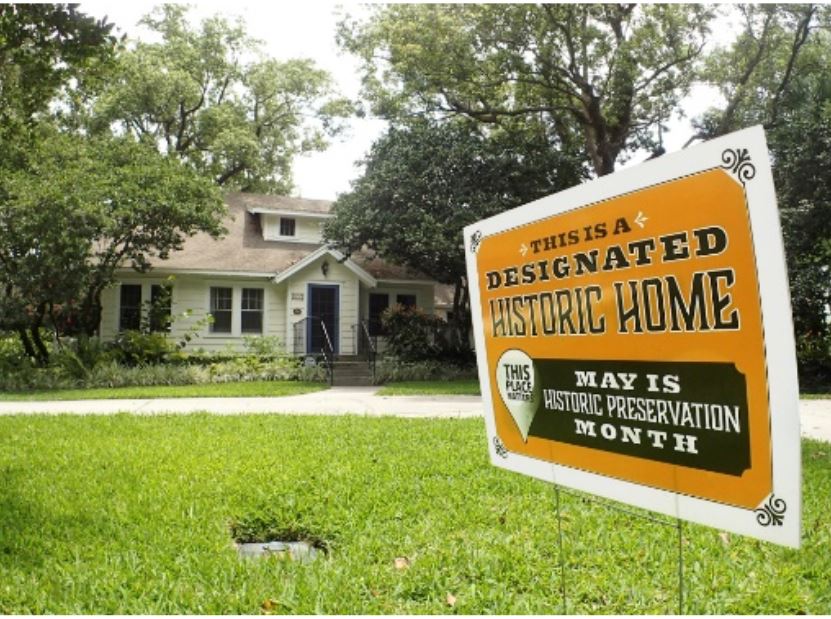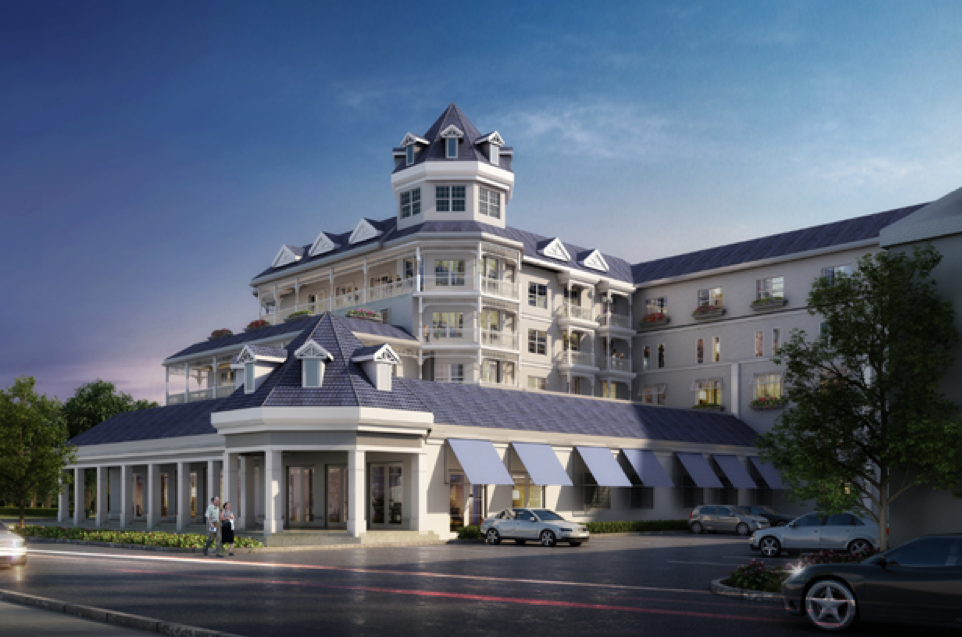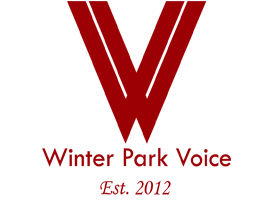
by Beth Kassab | May 7, 2024 | Historic Preservation, News, Uncategorized
Orange signs? All about historic preservation in Winter Park
May marks a time for awareness about historic properties and their value to communities like Winter Park
May 7, 2024
By Beth Kassab
Just as those election yard signs are disappearing, Winter Parkers might notice another sign popping up in yards across the city — Orange reminders of May as Historic Preservation Month.
Residents of historic homes are pulling out their signs as a visual reminder of the importance of preserving past architecture and charm to maintain the city’s vibrant character.
Winter Park’s Historic Register lists more than 120 homes and continues to grow each year.
Historic districts in the city include College Quarter, Virginia Heights East, Interlachen Avenue and the downtown area centered on Park Avenue.
Those in need of signs can contact the following: Sally Flynn: flynnlinks@aol.com; Stephen Pategas: spategas@hortusoasis.com or John Skolfield: john@skohomes.com
WinterParkVoiceEditor@gmail.com
To comment or read comments from others, click here →
by Anne Mooney | Jan 14, 2020 | Custom Author, Headline, Historic Preservation, Library, Orange Avenue Overlay, Zoning and Development
Marathon Monday Stretches into Terrible Tuesday
Meeting Will Continue on Thursday, Jan. 16
by Anne Mooney / January 14, 2020
Yesterday’s estimate of a five-and-a-half-hour Commission meeting missed the mark by a mile. For an unprecedented 11 hours, Commissioners struggled to make sense of two of the largest projects ever undertaken by this city – and failed.
OAO Discussion Continued to Thursday, Jan. 16
At 2:45 a.m., Commissioner Greg Seidel finally moved to pull the plug on the meeting, and the Commission agreed to ‘continue’ the Orange Avenue Overlay discussion on Thursday, January 16, at 11:00 a.m. Commissioners were advised to block out approximately four hours for the Thursday meeting.
At Thursday’s Continuance, Commissioners will vote on somewhere between 40 and 50 proposed amendments to the OAO ordinances.
As of this writing, the Thursday meeting is not on the January schedule of City meetings. Check the City website for updates or changes in dates and times. www.cityofwinterpark.org
Canopy Project
Earlier in the evening, the Canopy project met a similar fate. After an extended but inconclusive back-and-forth with the owner’s representative and the contractor, Brasfield & Gorrie, followed by the customary back-and-forth among the Commissioners regarding the Guaranteed Maximum Price (GMP), the item was tabled until the January 27 Commission meeting.
Commissioner Greg Seidel requested a Commission workshop to discuss such items as the contingency fund and possible sources of funds for the project. Likely funding sources include issuing the remaining $2 Million in bonds, the CRA, and the City’s General Fund. To date, the City has raised only about $2 Million of the promised $5.4 Million in donations.
Seidel also requested the results of Brasfield & Gorrie’s latest three large projects, to compare the (GMP) with actual costs upon delivery.
Agenda Angst
How the Canopy project and the Orange Avenue Overlay ended up on the same agenda is anyone’s guess, though there must be someone at City Hall who knows. The sheer volume of discussion and the number of amendments proposed is a clear indication that neither project is at a point where sufficient information has been digested for the Commission to come to a decision. The City needs to finish baking these cakes before anyone else cuts into them.
Record Crowd – Citizens Turned Away
Hundreds of people showed up at City Hall to listen or to speak. The building, including the downstairs lobby, was at capacity, and many citizens had to be turned away. Communications Director Clarissa Howard went through the crowd in the lobby and escorted those who wanted to speak up to the Commission Chambers and, in most cases, secured seating for them.
A Suggestion
Last night’s meeting demonstrated the folly of putting two mega-projects – especially ones around which there is a lot of positive and negative energy – on the same agenda.
The suggestion is the crafting of an ordinance that states, when a meeting is scheduled on a date certain, the meeting must be called to order and adjourned upon that date.
To comment or read comments from others, click here →
by Anne Mooney | Dec 10, 2019 | Custom Author, Headline, Historic Preservation
Waddell House Owners to Replace Porches
December 10, 2019 / by Geri Throne
Facing a daily city fine of $250, owners of Winter Park’s historic Waddell House told the city this week they plan to replace the rotted porches of the Victorian-styled structure.
“We want to work with the city not argue with the city,” David and Deborah Dunaway wrote in a letter dated December 9.
Last week, the city’s code compliance board ruled that the Dunaways violated the city’s historic preservation ordinance in July when they removed the home’s intricate two-story porch without a permit. It ordered the Dunaways to submit restoration plans in seven days or face a $250 fine for each day they remained in violation.
The letter included two sketches, one of the frontage of the house and the other of porch detail. “This is the first rendering of our plans to replace the rotted porches on our house at 1331 Aloma Ave.,” the letter stated. The sketches were said to be based on the home’s original design, as found in historic photos in the city library, and did not include “the add on or additions.” Additional architectural drawing and another permit application were promised to be submitted by Wednesday or Thursday of this week.
The home is named after William Waddell, a city pioneer who first occupied it. In 2005, long-time owners of the home had it put on the Winter Park Register of Historic Places before selling it. At the time, dense foliage in front of the home kept it mostly screened from view on busy Aloma Avenue. The Dunaways bought it in February of this year for $480,000 without an inspection. After they had the porch removed in the summer, highly visible blue tarps put over the front came loose, followed by months of rainwater intrusion.
At the code enforcement hearing, the couple’s attorney, Kevin Donaghy, asserted the house was structurally unsound. The Dunaways have “reached an impasse where they cannot afford to repair the entire home.” The Dunaways letter did not address how those structural issues would be addressed. Donaghy could not be reached for comment.
At a city commission meeting Monday, City Commissioner Todd Weaver and Mayor Steve Leary both praised city staff and the city Historic Preservation Board for their efforts toward preserving the structure.
To comment or read comments from others, click here →
by Anne Mooney | Nov 11, 2019 | Headline, Historic Preservation
Hannibal Square Historian Honored
Fairolyn Livingston Receives Cheney Award from Central FL Historical Society
 November 5 was a great day for Winter Park when the Historical Society of Central Florida bestowed the 2019 Cheney Award on Fairolyn Livingston, Chief Historian at the Hannibal Square Heritage Center.
November 5 was a great day for Winter Park when the Historical Society of Central Florida bestowed the 2019 Cheney Award on Fairolyn Livingston, Chief Historian at the Hannibal Square Heritage Center.
The Cheney Award is named for Judge Donald A. Cheney (1889 – 1983) who founded the Orange County Historical Society and the Orange County Historical Museum, predecessors of the current Historical Society and the Orange County Regional History Center. History Center Spokesperson Amanda Henry explained that The Cheney Award was created, “to recognize and honor those who have not chosen between the past and the future – but who understand the two are inseparable.”
“The award,” said Henry, “reminds us all of our champions of the Central Florida community who embody a love, reverence and unfailing dedication for our area’s history.”
Past Cheney Award recipients include the Orlando Sentinel’s Joy Wallace Dickinson (2013), Joseph Wittenstein of Rollins (2017) and James W. “Chief” Wilson (2018).
Fairolyn was honored for her work as Chief Historian at the Hannibal Square Heritage Center, where she has used her extensive research to enhance the permanent collection there. She has conducted interviews and written text for numerous exhibits, including the Center’s unique timeline installation, which juxtaposes significant events in local and national African American history.
She is a founding member of the team of documentarians, scholars and residents who in 2002 established the award winning show, The Heritage Collection: Photographs and Oral Histories of West Winter Park. This museum-quality documentary about the residents and history of Hannibal Square has been on permanent display since 2007, when the Heritage Center was established.
Fairolyn now devotes her time to the ongoing expansion of the Hannibal Square Heritage Center’s permanent collection, which includes “The Heritage Collection Phase IX: Hannibal Square Heroes (2017) and two phases of “The Sage Project: Hannibal Square Elders Tell Their Stories.”
The Cheney Award is only the latest in Fairolyn’s list of honors. She has received numerous awards and has shared the Hannibal Square community’s vibrant history with audiences across the state. In 2018, Winter Park Magazine recognized Fairolyn as one of Winter Park’s “Most Influential Citizens” for her contributions to understanding and preserving Central Florida’s history.
“Fairolyn Livingston’s invaluable research and outreach work have filled in many once-overlooked and under-appreciated chapters about a vital, important community centered around Hannibal Square in Winter Park,” said Orange County Historical Society Executive Director Michael Perkins. “We’re honored to present her with this award for her many contributions.”
To comment or read comments from others, click here →
by Anne Mooney | Nov 5, 2019 | Headline, Historic Preservation, Opinion
Can an Old House Weather This Storm?
Editor's Note: Articles written by citizens reflect their own opinions and not the views of the Winter Park Voice.
Guest Columnist John Skolfield
 The Waddell House at 1331 Aloma Avenue was built in 1901, the year Walt Disney, Ed Sullivan and Louis Armstrong were born, the year President William McKinley was assassinated and Theodore Roosevelt became the 26th U.S. President. Hurricane Donna may have roughed up the old house in 1960, but she stood firm and hardly blinked at the Cuban missile crisis. In the end, however, she was no match for the Tennessee attorney who sheared off her façade — the intricate porch design that had been the face of this grande dame for more than 100 years.
The Waddell House at 1331 Aloma Avenue was built in 1901, the year Walt Disney, Ed Sullivan and Louis Armstrong were born, the year President William McKinley was assassinated and Theodore Roosevelt became the 26th U.S. President. Hurricane Donna may have roughed up the old house in 1960, but she stood firm and hardly blinked at the Cuban missile crisis. In the end, however, she was no match for the Tennessee attorney who sheared off her façade — the intricate porch design that had been the face of this grande dame for more than 100 years.
Historic Designation in 2005
In 2005, Charles B. and Lurinda J. Smith had the home placed on the Winter Park Register of Historic Places. Mrs. Smith’s family had owned the Waddell House for well over 100 years. This act was intended to bring peace of mind and the assurance the house would be preserved and protected.
 Situated on 45,600 square feet of land, historic designation allowed the Smiths to subdivide a 90-foot lot on the east, while preventing further lot splits by future owners. The Smiths could have razed the old house and, with city approval, split the lot into three 15,200 square-foot home sites. They chose instead to preserve a bit of history.
Situated on 45,600 square feet of land, historic designation allowed the Smiths to subdivide a 90-foot lot on the east, while preventing further lot splits by future owners. The Smiths could have razed the old house and, with city approval, split the lot into three 15,200 square-foot home sites. They chose instead to preserve a bit of history.
New Owners in 2019
In February 2019, fully aware of the designated historic status and the protections this provided, David and Deborah Dunaway purchased the home for $480,000. According to an email from City Planning Manager Jeff Briggs, the Dunaways met with City staff to confirm their intention to restore the home. They indicated the porch was unstable and that they planned to remove and replace it exactly like it was. Staff advised that before they could do that, their plans had to go to the Historic Preservation Board for approval.
Porches Removed Within the Year
On the weekend of July 8, however, the Dunaways applied for a permit to remove the porches, and rather than wait for the permit to be granted, they had the front and rear porches removed without a permit on the weekend of July 13-14, just before they returned to their home in Tennessee.

City Issues Stop Work Order
On Monday July 15, the Building Department issued a Stop Work Order and directed the owners to submit plans for the restoration of the porches. A tarp had been draped over the roof, but it was improperly secured, and by mid-September, the house had endured two months of water intrusion — a house with horsehair plaster walls and heart of pine floors. Briggs emailed the owners, who said they would correct the problem, but by October 7, nothing had been done to secure the tarp to prevent water intrusion. There was no reply from the Dunaways.
‘Don’t Think We Can Fix It’
Briggs wrote that the owner later said he has retained the services of Orlando Constructors and Inspectors, “to do a complete appraisal of the structural integrity of the home to determine if repairs are possible and feasible or if the home needs to be demolished.”
The neglect of the house appears to be strategic.
City Ordinance Requires Reconstruction
On Tuesday, October 29, I met with City Manager Randy Knight, Assistant City Manager Michelle Neuner, City Planning Manager Jeff Briggs, Director of Planning and Community Development Bronce Stephenson, and historic preservation expert Christine Dalton. They confirmed that City zoning code, Section 58-500, requires the historically accurate reconstruction of the removed porches and provides for heavy penalties for illegal removal.
Demolition by Neglect
In an email to Jeff Briggs, Christine Dalton, formerly Historic Preservation Officer for the City of Sanford and currently a Trustee of the Florida Trust for Historic Preservation, expressed her concern about the condition of the Waddel house. “With the information I have received so far,” she wrote, “it appears obvious that the property owners are engaging in Demolition by Neglect. They are dismantling the home and have not properly protected it from the elements. As you know, this is a strategy of many property investors – create conditions for deterioration, then hire a structural engineer to write a report stating that the building is unsafe and therefore must be demolished.”
Case Goes to Code Enforcement Board Dec. 5
On November 1, the City sent the owners a Notice of Violation advising them that a Public Hearing before the Code Enforcement Board was scheduled for 3:00 pm on December 5, 2019. The description of the violation was “Porch Structure Removed Illegally Without a Permit.”
Stated Compliance Requirements were, “Submit Plans for the Restoration of the Porch Removed Without a Permit,” with a deadline of November 15, 2019.
According to Briggs, “Nothing can happen with the home until a proposal/plans are submitted to the HPB [Historic Preservation Board], or (upon appeal) the City Commission can approve the demolition of the home.”
To comment or read comments from others, click here →

by Anne Mooney | Oct 28, 2019 | Headline, Historic Preservation
The Henderson Hotel at Lake Killarney
What’s Going On There?
 There is a great deal of information flying around about the 118-room Victorian style hotel proposed for a site on 17-92 that fronts on Lake Kilarney. Several meetings are scheduled for this week and next that should shed some light on what is actually happening. If this is a project that affects you – or just interests you – plan to attend one or more of the following meetings.
There is a great deal of information flying around about the 118-room Victorian style hotel proposed for a site on 17-92 that fronts on Lake Kilarney. Several meetings are scheduled for this week and next that should shed some light on what is actually happening. If this is a project that affects you – or just interests you – plan to attend one or more of the following meetings.
Tuesday, Oct. 29 — Planning & Zoning Work Session, Noon, Commission Chambers
The P&Z Board will discuss the zoning changes and conditional use requests for the proposed hotel. This is for informational purposes only. The board members will take no votes and hear no public comment – but the meeting should be informative.
Wednesday, Oct. 30 – Developer’s Information Session, 6 – 7 pm, Farmer’s Market
The developer, Adam Wonus, will host a Q&A and show the latest concept drawings at the Farmer’s Market. If you have questions about the project, here’s your chance to ask. Word on the street is the neighbors, not all of whom favor the project, plan to be in attendance.
Tuesday, Nov. 5 – Planning & Zoning Board Meeting, 6 pm, Commission Chambers
This will be the formal P&Z hearing, where the board will vote on whether or not to move the Henderson Hotel project ahead to the Commission in late November. Votes will be taken and public comment will be heard.
To comment or read comments from others, click here →








Recent Comments